New York City, July 30, 2014

★★★★★ Traffic sounds and cool air carried through the still-open windows. The sky was cloudless at first, with a thin white tinge to the blue, the sun benevolent and warm. Bicycles were everywhere, going the wrong way in the bike lanes. A group of men walked together wearing different-colored but otherwise similar trim shorts. Drumming rose from Verdi Square. A few midday clouds puffed up in the west. Nearly every seat on the plaza was taken for lunch; a row of day campers in blue t-shirts perched on the low wall just by the fountain. By afternoon, the bricks were strewn with water-balloon scraps and the whole space rattled with scooters. The clouds had advanced throughout the sky, and had enough gray mixed in their billows to generate little stretches of moodiness on the walk down Broadway. There was a chilled bottle of white wine by the corner of the playground, behind the stack of pizza boxes and the streamer-wrapped benches, a loosely bounded party. The birthday guests bounced sturdy jumbo balloons on rubber-band tethers and warred with Silly String till the pavement was a ’90s graphic backdrop. Other children wandered by in their underpants, drenched by the fountain. The two-year-old batted his balloon up in air the over and over again, following it all the way across the paved yard on the westbound breeze. He could see no reason to stop playing, long after he’d had his fill of cupcake frosting. By the time he finally allowed himself to be rolled home on his scooter, the apartment was awash in coral-colored light.
Alternate Names for the Neighborhood Unfortunately Referred to As "Quooklyn" by the New York Times...
Alternate Names for the Neighborhood Unfortunately Referred to As “Quooklyn” by the New York Times, Ranked
by Brendan O’Connor

1. Woodbush
2. Ridgewood
3. Bushwood
4. “Well my mailing address is Queens but I feel like I live in Brooklyn.”
5. Bushridge
6. “I mean I live off the L, so.”
7. Wickridge
8. Ridgewick
9. Woodwick
10. Wickwood
11. “But Queens really is great.”
12. Bushwick
Brendan O’ Connor is a reporter living in Quooshkwick.
Photo by C-Monster
Geocaches for the True Adventurer
by Awl Sponsors
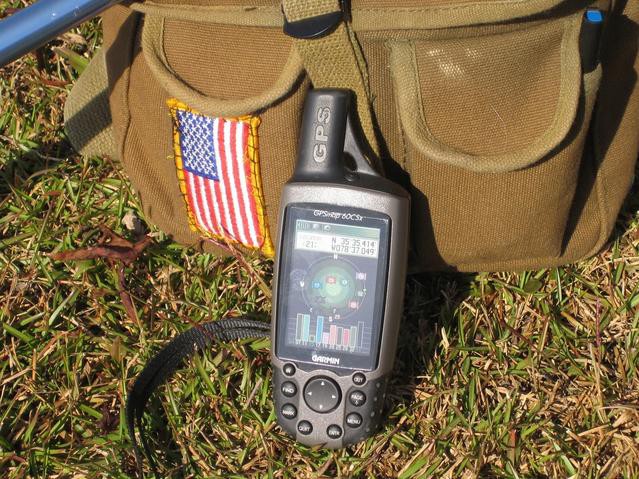
Brought to you by Pacifico
In case you’re not familiar with the increasingly popular outdoor activity known as “geocaching,” prepare to have your mind blown. In geocaching, participants use GPS and other navigational devices to hide and seek “treasure chests” called geocaches anywhere in the world. This modern day Indiana Jones activity allows a person to sign a logbook within the cache as proof that they actually made the journey, and also to trade “treasures” inside the chest.
Check out below some of the most adventurous geocaches for the bravest of the brave. When done, head over to discoverpacifico.com to explore more off-the-beaten-path destinations thanks to GPS coordinates found under every Pacifico beer bottle cap.
International Space Station

We would argue that this is the most remote location of all geocaches in existence. In 2008, a private ‘space tourist’ named Richard Garriott left a geocache in locker #218 of the Russian segment of the International Space Station (ISS). With the ISS constantly floating about 250 miles above the earth, this cache is essentially moving at nearly 17,000 miles per hour as it circles the earth, which is fast enough to complete an orbit every 90 minutes!
Mount Everest Summit

This geocache exists for the most skilled mountaineers. Set on top of the tallest mountain range in the world, this geocache is close to 30,000 feet about sea level. To locate this geocache involves braving fierce winds, spasmodic weather condition changes, and extreme altitude.
The Leap

You pretty much have to be Indiana Jones’ soul sister or brother to find The Leap geocache. Located in Arizona, The Leap requires an incredible set of feats; steep hills, numerous drop-offs and cliffs, gigantic boulders and formidable terrain. The last few feet to the geocache demand a Super Mario Bros video game skill; jumping four to five feet leaps from rock to rock. Misjudging leaps means falling a very deadly plummet of over 100+ feet to the bottom.
Registan Desert

The Registan Desert Earth Cache is found right in the middle of Afghanistan. The dry and treacherous desert can be discouraging, but according to Geocaching.com, over 35 people have visited and logged the cache here!
The Secret Falls of Kimbuma

The Secret Falls of Kimbuma cache is located in one of the most underdeveloped and dangerous countries on the planet. Fearless souls must cross the treacherous Wamba River and endure a perilous hike across risky jungle terrain. On top of that, very few people outside of the Democratic Republic of Congo actually speak local languages, making the journey even that much more inconceivable.
Now that you’re well-versed in geocaching, grab a Pacifico Beer and use the GPS coordinates under the bottle cap to explore some more accessible, incredible locations at discoverpacifico.com.
Is Your City Poor Enough to Star in the Next Hit Video Game?
Is Your City Poor Enough to Star in the Next Hit Video Game?
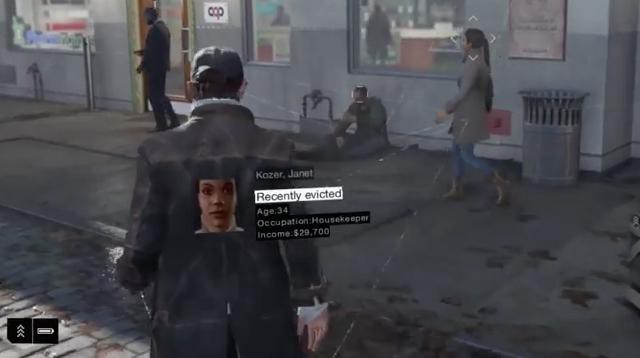
“The city of Camden, New Jersey had the highest crime rate in the US in 2012. A 24/7 surveillance program is now in effect,” teases Ubisoft, the enormous French game publisher, announcing a new expansion of its popular Watch Dogs sneak-hack-and-kill game. The original, which was pitched as one of the most ambitious games of all time, was set in and around a fictionalized Chicago populated by an automatically generated cast of lightly stereotyped city-dwellers. Earlier this year, a player found himself under attack by a hoodied young virtual character named “Kavon Fortin,” which company representatives claimed was an unfortunate coincidence. Within a few months another Ubisoft game, Far Cry 4, was advertised with a human colonial tableau, which the company might have been able to explain away if not for the franchise’s extremely recent history (as well as an adjacent controversy surrounding its flagship series).
The Grand Theft Auto series takes place in satirical renderings of New York, Los Angeles, San Francisco and Miami, and mostly inhabits their criminal underworlds. But its cities are backdrops — these games can depend on their players knowing that Los Angeles is place where actually humans live a variety of lives, on Earth. This is one of two ways most major video games engage with real places, the other being after their total destruction (in a past or future war, or after an alien invasion). Which treatment will Camden get? Game site Polygon’s attempt at context for the announcement:
In 2012, the FBI named Camden as the most violent city in the United States with a population of more than 50,000. It ranked first in homicides in 2011, based on its population of 77,000.
So maybe a new treatment, somewhere in between: It will use the public’s glancing understanding of Camden as “poor” and “in trouble,” as a statistically superlative cautionary tale without any human character at all, as a backdrop for an apocalyptic playground of its own creation. Watch Dogs: Camden will be a guaranteed hit in the Philadelphia suburbs.
Death of a Denim Wizard
by PJ Vogt
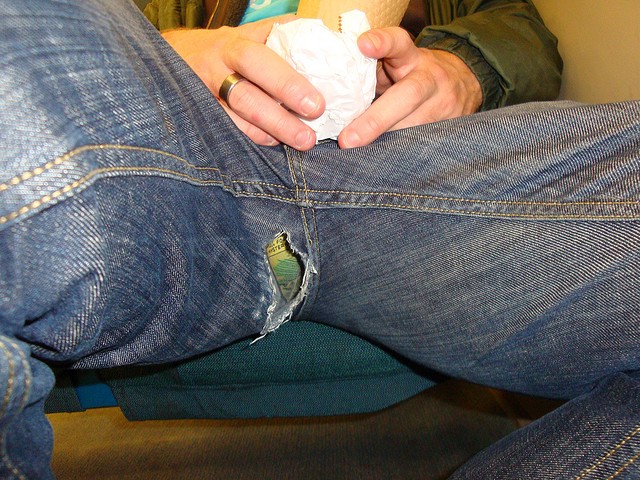
A couple of years ago, I went to get my jeans mended at a store in my neighborhood called Kill Devil Hill. It mostly sold New-Old Brooklyn tchotchkes — nice soaps, pharmaceutical brown bottles, fancy combs — but in the back of the shop was a tiny denim repair business. When I mentioned being embarrassed about the crater-sized holes in the crotch, the person behind the counter told me that, actually, crotches on jeans fail all the time; most jeans, if they fail, fail in the crotch. Since the repairs are cheap — twenty dollars or so — there’s a small army of people walking around with mended, reinforced, double-strength, nearly indestructible crotches.
So last week, when a friend told me that he was planning to buy some replacement jeans with a strong, healthy crotch, I informed him that he should just get his old jeans mended; he not only didn’t know about denim menders, but had no idea that crotch holes were the most widespread epidemic of our time. His confusion was so profound that I wondered if the person at the store had told me a polite lie — was the crotch hole epidemic really just me? So I went back to investigate.
There was a prominent sign in the store window:
PUBLIC ANNOUNCEMENT
WE ARE NO LONGER OFFERING SERVICES IN DENIM REPAIR
The woman who used to work there was gone. In her place was a soft-spoken teenager named Wyatt. He lives a few blocks away from the store. After a summer class at FIT, he discovered that he liked sewing, and walked into Kill Devil Hill to ask if he could intern for them. Now fifteen, he works a couple of days a week. He told me that the reason the store had phased out denim repair was because it wasn’t very lucrative; they made more money selling aprons.
When did the store start to phase out denim repair?
It took us two months to get rid of it. People were coming in and we were like, “Fine. One more pair, one more pair.”
What kind of jeans would people bring in to get repaired?
They’d tend to be high quality jeans. The pricing range was two hundred dollars and up. That’s the culture of denim repair: You don’t spend repair money on sixty-dollar jeans. I guess you might on jeans you’ve spent a lot of time with. The crotch blew out, the knees blew out — do you know a lot about raw denim?
Only a little bit.
So the whole thing is: you don’t wash your jeans. Most of my pairs I haven’t washed in nine months. When you wash jeans, it’s not that good for the denim. You don’t wash your jeans, they get fades, they get dirty. There are marks called the whiskers, that’s here —
— along the pocket?
Yeah. The marks behind the knees are called honeycombs. And most people, when you buy selvedge denim, you cuff it. If there’re cuffs, and you unroll the cuffs, you see faded lines. They’re called stacks.
It feels like — I know this is something adults are into — but it feels teenaged. Just because it’s a hobby with a lot of slang and language. You know?
Yeah. It’s weird, but I don’t see it much at school. Even though it does sound like that. Me and my best friend at school are the only ones with knowledge of selvedge jeans. All the other kids were wearing Levi’s and stuff like that. We were wearing APC and like, one of my favorite companies is Acne Studios. Which is like a designer brand.
When you would wear the better jeans, would kids notice?
I feel like even if they didn’t notice, I noticed. I knew. I can feel a difference between higher quality denim and lower quality or average quality. But I don’t think many people notice. I always think people are more observant than they are. It’s just another pair of jeans to somebody.
What kind of repairs do people tend to get? Is there a specific repair people get all the time?
The crotch repair. The crotch will rub up against your seat when you’re biking. That’s a pretty popular one. Also, the knee. I’d say knee and crotch — er, seat. “Seat” is less vulgar or whatever.
I got a pair of jeans repaired here maybe a year ago, and I was embarrassed because I felt like I had huge thighs that had destroyed my jeans.
It’s just where it fails. It’s pretty popular that the crotch will wear out. Er, the seat.
What about when people’s pockets show through because of their cellphone or their wallet? Is that even fixable?
Yeah. You can take the pocket off and replace it. You can remove the pocket and then fix the pocket and sew it back on. We can pretty much fix anything.
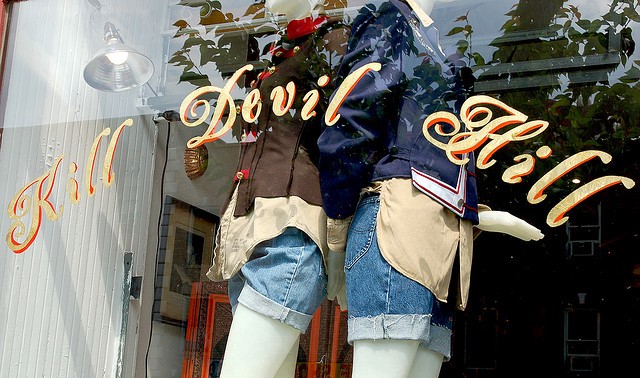
Do you think that there’s certain neighborhoods where you’re more likely to see a denim repair business?
Yeah. Greenpoint and Williamsburg, because of the hipster and fashion culture that’s emerged from these neighborhoods — the high quality jeans and the biking, where you destroy your seat.
I have a friend who just finished med school and she said she sometimes looks at strangers on the street and catches herself diagnosing them. Do you do that with people’s jeans?
I guess, probably. Since I started working here I notice — every time I’m walking down the street I notice — that guy’s wearing APC, that guy’s wearing Ralph Lauren. That guy bikes a lot, his seat is repaired.
It’s funny too. I feel like denim culture is people learning how to look at jeans, become like connoisseurs of jeans. But they might not have an appreciation for why good jeans work or why they’re better made.
The mender I remembered from a couple of years ago came into the store with her son, who is now a toddler.
This is my boss, Mary.
Hi! I’m doing a piece about denim repair, a business which you guys are out of now.
M: Oh, yeah, we’re out of the business of denim repair. It sucks ’cause I really liked the denim repair business.
How come?
I liked fixing something. Making the life of it longer. It was a service I believed in — it just became logistically difficult. I realized to keep doing it I’d have to up my prices. I was already the cheapest, and I figured, well, I either make people mad by upping my prices or I make them mad by not doing it.
I was checking your hours before I came and someone on Yelp was crazy mad that you’d stopped repairing denim, as if you were a hospital that had shut down.
I know. People have been really upset. You can’t make everybody happy all the time. And I only have this space to work in. If I had a way huger space, I’d consider doing it. But also, to be honest with you, I started getting horrible denim repair people.
What are horrible denim repair people like?
For the first few years I did it, everyone was so happy to have their jeans done. But since last November up to when I quit, I started getting these really, absurdly high-demanding people. Over like, a ten-dollar fix. They’d scream at me, yell at me, refuse to pay, to the point where I thought, I don’t need to get yelled at. Go pay more money somewhere else and yell at them. I had a woman who yelled at me for not doing her jeans on Christmas.
Seriously?
She came the day after Christmas, and I said, “I’m really sorry, we’re behind, it’s Christmas right now and we’re a retail store.” She said, “This is unacceptable, I shouldn’t have to pay anything. I had to take a thirty-dollar car ride.” And I was like, “I didn’t tell you to pay $30 to get over here.” Why wouldn’t you even call — it’s the day after Christmas, why would you even think I would be here? She was so horrible. I almost quit doing it at that point; I just thought, “People are crazy.”
That’s so insane. It makes me so embarrassed for my team, the customer team.
It got crazy. It was weird. We talked about it as a staff. To Victoria, who’s been with me the longest, I was like, “Have you noticed this too? Have I gotten more sensitive?” And she said, “No, it’s the customers.” It had gone from one mad person once every four months — someone you could still make happy — to, in the past months, just — really horrible people.
PJ Vogt hosts On the Media’s TLDR, a podcast about the internet.
Photos by RD the Milkman and Curious Expeditions, respectively
FKA Twigs, "Pendulum"
FKA Twigs, “Pendulum”
The aesthetic incongruity of each new FKA Twigs song is starting to wear off, and all the styles are starting to settle together; if you were trying to make some kind of point, you could probably get away with saying she makes industrial music.
Moon Stupidly Shaped

Rather than do literally anything else, scientists have spent forty-five years trying to decipher the true shape of the fucking moon, which is apparently “like a lemon with an equatorial bulge,” according to the author of the absolutely pointless study. The Times writes:
Efforts to pinpoint the moon’s exact shape have long been stymied by the presence of large craters on its surface that formed after the crust solidified. There have also been inconsistencies between its measurements and what we know about its past.
For example, the moon barely spins, yet it appears to have the sort of equatorial bulge caused by rotation. And why would a giant ball of cooled liquid be anything but spherical?
Intriguing questions! If they weren’t about the stupid moon.
New York City, July 29, 2014

★★★★★ Even in stillness, there was a distinct chill on the morning air. The high land in the far northwestern distance in New Jersey was plain and clear on the horizon. The sun raised bright white highlights on the cheeks and scalps of people walking beside the vast reflecting surfaces of the Time Warner building. Downtown, in dappled tree shade, it raised blinding spots from the top of SUV. Conditions kept subtly shifting: light and shade, warmth and coolness, gray and white. The edges of the clouds were now indistinct, now distinct. One could walk in it for blocks, looping out of the everyday pattern. Down Lafayette lower than usual, the open back door of a completely empty restaurant framed sun-soaked trees. Someone had installed an arrangement of a Spider-Man figure and a dangling flesh-toned phallus on an overhead wire at Broome Street, the phallus turning in the air currents. The late sun was as soft as the morning sun had been hard — a prettily colored disc descending. The night was mild, taxis plentiful, the emergency room efficient and almost calm.
Lewis, "So Be In Love With Me"
Here is a track from the second album by the mysterious Lewis, who, with his exhumed debut vanity record, L’Amour, became a small internet sensation. This one was recently discovered in storage at a Calgary record store. Still no sign of the man himself:
Sourced soon after the re-release of L’Amour, Romantic Times is the 1985 follow-up to L’Amour — and it’s released as Lewis Baloue. The name may be slightly different, but this is absolutely our man: a familiar blond posing on the sleeve, a familiar, tortured voice pouring his heart out over languid synths and synthetic waltz beats.
Moral Calculus Elucidated
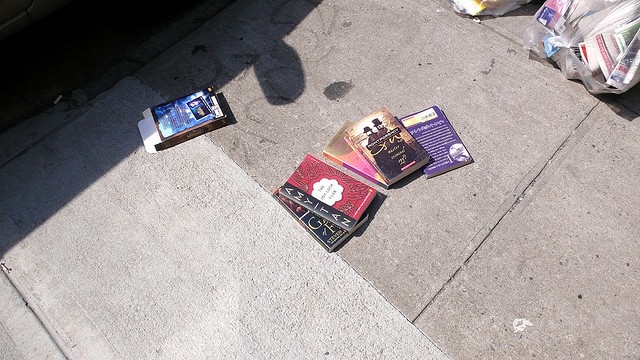
Amazon, apparently no longer all that comfortable with the role that it has settled into during the course of its ongoing standoff with the publisher Hachette — unrepentant and unyielding monopoly monster — now wishes to explain itself:
It’s also important to understand that e-books are highly price-elastic. This means that when the price goes up, customers buy much less. We’ve quantified the price elasticity of e-books from repeated measurements across many titles. For every copy an e-book would sell at $14.99, it would sell 1.74 copies if priced at $9.99. So, for example, if customers would buy 100,000 copies of a particular e-book at $14.99, then customers would buy 174,000 copies of that same e-book at $9.99. Total revenue at $14.99 would be $1,499,000. Total revenue at $9.99 is $1,738,000. … Is it Amazon’s position that all e-books should be $9.99 or less? No, we accept that there will be legitimate reasons for a small number of specialized titles to be above $9.99.
This is all strictly true, of course — numbers don’t lie, except when they do — if you grant Amazon its central premise, which is that all books (except those exceptional exceptions!) are worth precisely one penny less than ten dollars, regardless of what’s inside of them.
Photo by Conrad Bakker
